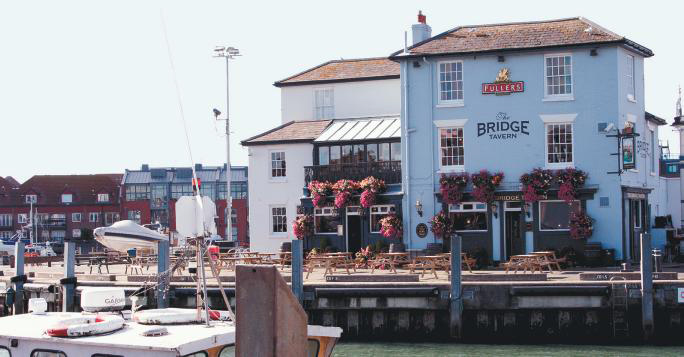
Home of the Royal Navy, seat of the Empire’s maritime power, and beautiful Hampshire cathedral city.
For many visitors, Portsmouth has got it all. Best of all, whether for a day trip or overnight excursion from London, the small city is easily accessible by train from London. Drive down in a couple of hours, or catch a train from Victoria Station hourly for the 90-minute ride through Hampshire to Portsmouth Harbour.
Portsmouth is also the principal staging port for goods and people to the Isle of Wight, as well as a terminal for international ferries to Brittany and the Channel Islands. You can see it all from the observation deck of the Spinnaker Tower on Gunwharf Quay, just steps from the station.
With a city of 200,000, there is no shortage of lodging in all categories. The TIC across from the Harbour train station can help with any arrangements, or explore the options at www.visitportsmouth.com.
Location, Location, Location

From the Spinnaker Tower, the view northwest to Southampton takes in the pleasure boat marina tucked into a back corner of vast Portsmouth Harbour.
Here’s an inside tip, though. Right on the waterfront across the bustling bus stand, station entrance, and street stands a tattered old waterfront hotel The Keppel’s Head. Yes, it’s seen better days, but the price is more than right—and nowhere in Portsmouth is in second place for location.
Take a room in the back if you need the quiet, or a room in the front with big old windows looking out over the Wight ferry terminal, and watch the international ferries, British naval ships and cargo ships from around the world on the channel into Portsmouth’s vast harbor. Just below is the HMS Warrior, the first iron-hull screw-prop battleship in the world. They called it the “Peacemaker,” and for a generation, Warrior kept peace in the British Empire’s Atlantic outposts. Just steps down the street lies the entrance to Portsmouth Historic Dockyard.
Portsmouth’s Star Attraction

The situation room map recreated at the D-Day Museum shows the invasion plan for June 6, 1944
It’s almost not fair to call Portsmouth Historic Dockyard a single attraction. It’s been around since Richard the Lionheart summoned his fleet and army there to set out on the Crusades in 1194. Here’s a place you really can’t see in a day. In addition to the HMS Warrior, it is home to HMS Victory well known as Nelson’s flagship at Trafalgar and Henry VIII’s doomed flagship Mary Rose. There’s also the Museum of the Royal Navy—with no small history. Buildings of exhibitions on naval life, historic maritime technologies and an interactive adventure zone come along for the ride.
Take a harbor tour as well (and do), joining the maritime traffic past state-of-the-art Royal Navy frigates and destroyers and decommissioned hulks waiting to be hauled away, past the ferry terminals and cargo quays where every couple of days a freighter from South America pulls in with 48 million bananas. you can buy tickets to attractions individually or get a package ticket that includes the harbor cruise. To the other side of Keppel’s Head, it is about 100 yards to the pedestrian tunnel entrance to Gunwharf Quay. The waterside mall with scores of upscale shops, restaurants, pubs and more overlooks marinas of pleasure boats and small yachts and all the floating action of the harbor entrance. On the quay stands 555-foot Spinnaker Tower overlooking the Solent and the Isle of Wight.

Quays and jetties harbor-side reflect centuries of Portsmouth’s maritime life.
Take a taxi to Southsea Esplanade. This is Portsmouth’s beach, with all the usual seaside fun on Clarence Pier. On the esplanade, Britain’s D-Day Museum tells the story of the Normandy invasion, now 70 years ago, and the central role Portsmouth played in its launching. Facing the sea, Southsea Castle was built against invasion by the french; from there King Henry watched the Mary Rose go down. Today, the castle a Portsmouth City Museum, is open free to the public.
A Bit of Old Town Portsmouth
If you decide to walk back to the old waterfront, do stop to visit Portsmouth Cathedral. It contains the memorial grave to those recovered from the Mary Rose. A few blocks north and removed from the waterfront, Portsmouth’s old city center is still a vibrant hub of activity centered around a broad square in front of the magnificent Guildhall (with galleries open to the public) that is city hall. All around are the accouterments of healthy English urban life: cafes and shops, pubs and markets.
Portsmouth is a fun town. To try to do all in a day is futile, but if that’s the time you have, just take your pick of the riches and have a good start. If that is the time, though, stick to the old waterfront.
In the Vicinity
Further afield isn’t far. Just west on The Solent lies Southampton, long England’s principal passenger port for ocean liners. Alfred the Great’s Saxon capital of Winchester is not more than half an hour up the road. East on the coast, it’s a great drive over through Chichester and Arundel to Brighton. It is riches as always.
* Originally published in 2014. Updated in 2023.










Comments